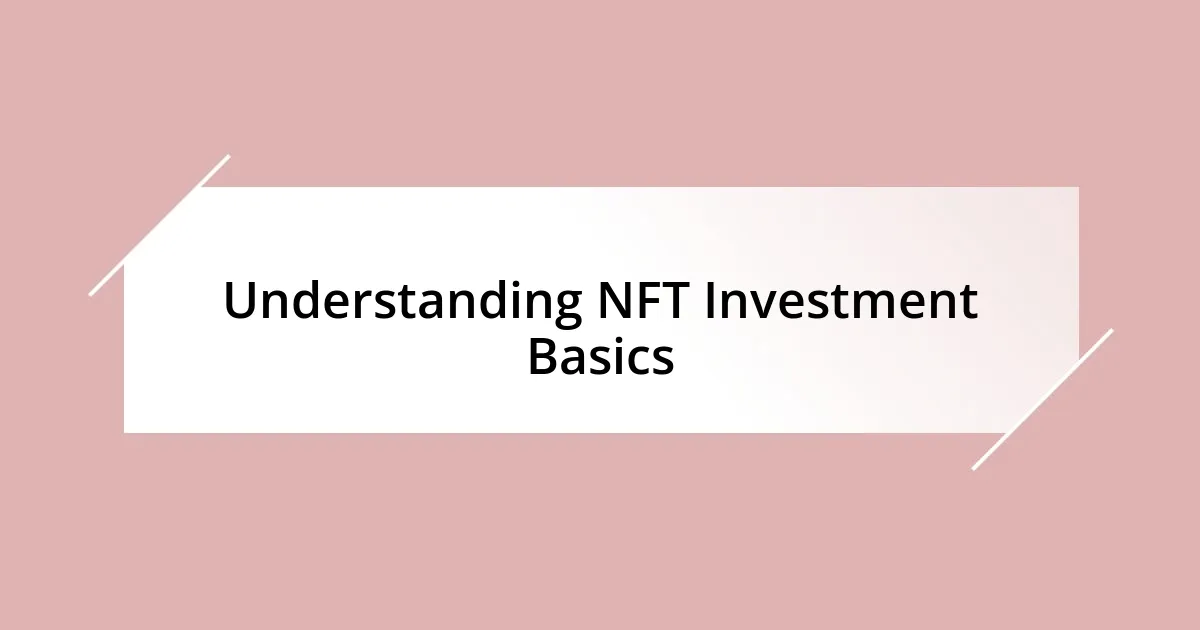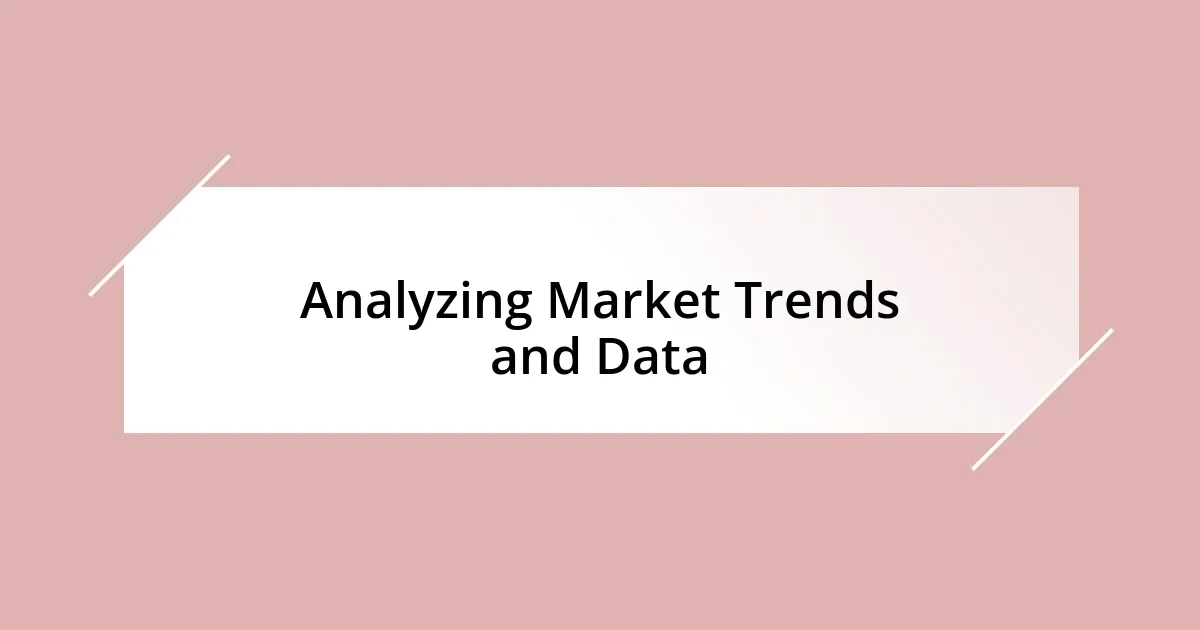Key takeaways:
- NFT investment requires thorough research, understanding market trends, and evaluating the creator’s credibility and community engagement.
- Diversification within an NFT portfolio is essential for stability; include various asset types and consider up-and-coming projects that align with personal values.
- Reselling NFTs profitably involves strategic timing, community engagement for insights, and storytelling to create emotional connections with buyers.
- Assessing a project’s roadmap and team credibility is crucial for ensuring long-term investment potential and recognizing momentum in the project’s development.

Understanding NFT Investment Basics
When diving into NFT investments, I often remind myself that these digital assets represent ownership of unique items on the blockchain. It’s fascinating to think that a digital art piece I admire can have a value tied to its scarcity and provenance, much like traditional art—but with the added layer of immutability that blockchain provides. Isn’t it amazing how technology can redefine what we view as valuable?
Navigating this landscape can feel overwhelming at first. I remember when I bought my first NFT; the thrill mixed with anxiety was palpable. I found myself asking, “Did I make the right choice?” Over time, I learned that understanding market trends and the communities behind projects is crucial. It’s not just about the asset itself, but the story and engagement that accompany it.
One essential aspect to grasp is that NFTs aren’t a guaranteed path to riches; they require due diligence. I’ve seen some friends jump in impulsively—falling in love with flashy graphics but ignoring the importance of research. Have you ever made a quick investment without fully understanding it? It taught me that patience and informed decisions lead to more satisfying results in the long run.

Key Factors for NFT Selection
When I evaluate potential NFTs, I focus heavily on the creator’s credibility and background. For instance, I once purchased digital art from an artist with a solid reputation and previous successful drops. That experience reinforced for me how valuable an artist’s portfolio can be; it gave me greater confidence in the investment.
Another factor I consider is the community and ecosystem surrounding a project. A while back, I joined a Discord group of about 200 members centered on a new NFT collection. Engaging with others who shared similar interests helped me grasp the project’s potential and its long-term viability. Strong community involvement often translates to better support and advocacy for the project, increasing potential value.
Lastly, I can’t stress enough the importance of utility attached to NFTs. I once acquired a piece that not only served as a collectible but also granted me access to exclusive events. That added layer of value made me appreciate the investment even more. It’s incredible how some NFTs can transcend mere ownership and integrate into broader experiences.
| Key Factor | Description |
|---|---|
| Creator’s Credibility | Focus on the artist’s background and past successes. |
| Community Engagement | Consider the strength and activity within the project’s community. |
| Utility | Evaluate the additional benefits that come with owning the NFT. |

Analyzing Market Trends and Data
Tracking market trends and analyzing data can seem daunting, but I’ve found it to be utterly rewarding. I often turn to platforms that provide real-time analytics on NFT sales, as understanding fluctuations helps me spot potential opportunities. For example, during a recent surge in interest for retro-style NFTs, I quickly shifted my focus and made some savvy purchases before the hype reached its peak.
Here are some vital data points I consider when analyzing market trends:
- Sales Volume: Keeping an eye on the sales volume helps me gauge popularity. Higher activity often signals a thriving project.
- Price Change Over Time: I’m always curious about price history. Observing how prices responded to market shifts can indicate stability or volatility.
- Rarity Metrics: Items with unique traits generally fetch higher prices. I make it a habit to check rarity scores to find gems hidden among the crowd.
- Community Engagement: Activity on social media and forums reflects interest levels. When I see passionate discussions, it often reveals long-term value potential.
By combining these insights, I’ve been able to make informed decisions about my NFT investments. It’s almost like piecing together a puzzle, where each data point adds depth to my understanding of the market dynamics at play.

Diversifying Your NFT Portfolio
When it comes to diversifying my NFT portfolio, I often think of it like assembling a balanced meal. Just like how I wouldn’t only eat pasta for dinner, having a mixture of different NFT types can provide more stability. For instance, I made a conscious effort to acquire not just digital art but also music NFTs, virtual land, and even utility-based tokens. This variety has given my collection depth, making it less susceptible to the whims of any single market trend.
One experience stands out: I decided to invest in a gaming NFT alongside my art pieces. Initially, I was hesitant because I didn’t know much about gaming assets. However, as I began researching, I realized the gaming NFT market was booming. It felt exhilarating to tune into that energy, and I ended up purchasing items that significantly appreciated in value. Sometimes, taking that leap into a new type of NFT can be a thrilling experience—it’s like discovering a hidden gem!
Don’t forget about the importance of including up-and-coming projects in your diversification strategy. I recently discovered a new project that combined environmental sustainability with NFT art. It felt meaningful to support something I truly believed in. This approach not only broadens my portfolio but also aligns my investments with my values. How often do you think about the impact your investments could have beyond mere financial gains? Finding that balance can turn your NFT investments into a rewarding journey.

Strategies for Profitable Reselling
Reselling NFTs profitably requires me to be strategic about timing and choice. I’ve learned that waiting for the right moment can make a world of difference. When I purchased a limited-edition collectible, I felt an immense rush of excitement. I kept a close watch on its popularity, and when the buzz peaked, I relished the chance to flip it for a significant profit. Isn’t it exhilarating to turn a passion into profit?
Another strategy that has proven beneficial is leveraging social media and community groups. Engaging with fellow NFT enthusiasts can provide invaluable insights. I remember browsing a Discord server where a member shared an upcoming drop from a lesser-known artist. I took a chance, bought a couple of pieces, and ended up selling them days later for a handsome return. How often do you engage with your NFT community? Those conversations often turn into hidden opportunities.
Finally, I always stay attuned to the emotions that resonate with buyers. For me, it’s about storytelling. When I resold an NFT that had a compelling backstory, I noticed that collectors were more willing to pay a premium. They weren’t just buying a digital asset; they were investing in a piece of a narrative. That connection makes all the difference, doesn’t it? Understanding and sharing the emotions behind the art can truly elevate your reselling game.

Assessing NFT Project Roadmaps
Assessing a project’s roadmap is crucial in my investment decision-making process. A well-defined roadmap provides transparency on a project’s future developments, including upcoming features and community initiatives. I recall evaluating a project where the team outlined quarterly goals, like partnerships or gamified experiences. This clarity not only built my confidence but also kept me engaged with the project’s evolution. How often do you find yourself drawn to a project simply because the vision resonates with you?
It’s essential to look at milestones already achieved as well. During my exploration of a recent NFT venture, I noticed they had successfully completed significant phases like token launches and community engagement events. The sense of progress was palpable, which made me feel secure in my investment. Have you ever felt that thrill of investing in something that’s already making strides? That sense of momentum can change the game entirely.
Finally, I always consider the team behind the project. Their credibility and past experiences can significantly influence a project’s success. I once backed a promising project because the creators had a solid history in the tech space. Their enthusiasm for building something groundbreaking was infectious. Isn’t it exciting to invest in a project where the team feels genuinely passionate about their vision? Recognizing this passion can often set apart successful projects from the rest.

Avoiding Common NFT Investment Mistakes
It’s easy to get caught up in the hype and overwhelm oneself in the NFT space. I remember my first big purchase; I was swept away by the flashy graphics and influencer endorsements. My eagerness blinded me to the fact that the underlying project lacked depth. I learned the hard way that due diligence is essential. Have you ever jumped into something without fully understanding its value? That realization cost me, but it taught me to always research thoroughly before making any investment decisions.
Another common mistake I’ve seen—and experienced—is the tendency to follow trends blindly. A friend of mine once invested in a flurry of meme-based NFTs, thinking they’d quickly appreciate in value. Unfortunately, the trend fizzled out, leaving him with digital assets worth a fraction of what he paid. It made me think: How often do we let FOMO (fear of missing out) dictate our choices? I always remind myself to evaluate the sustainability of the project rather than just riding a temporary wave.
Lastly, I can’t stress enough the importance of not getting emotionally attached to an asset. I’ve made this mistake, too. Holding onto an NFT because I loved it didn’t always align with my investment goals. I learned to separate my personal affection from my judgment as an investor. Isn’t it tough to let go when you’ve developed an emotional connection? Recognizing this, I now focus on my overall strategy and keep my emotions in check. Balancing passion with pragmatism is crucial in this volatile market.












